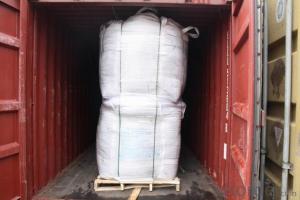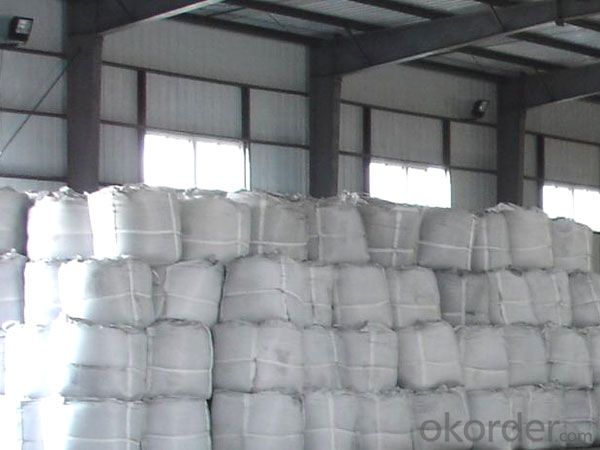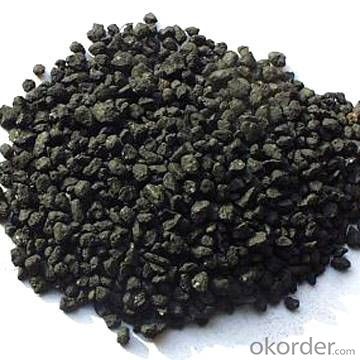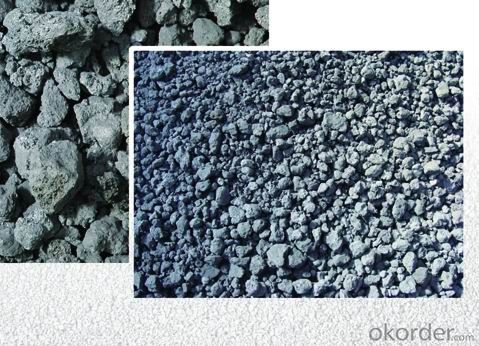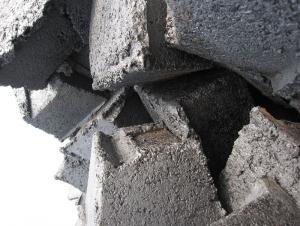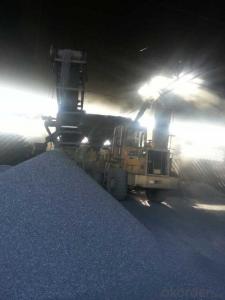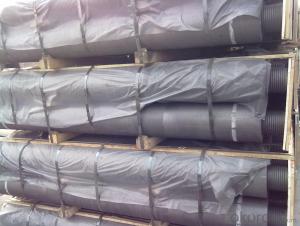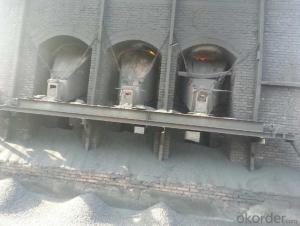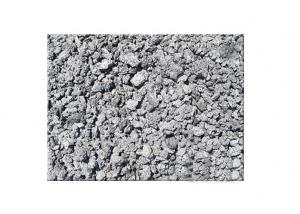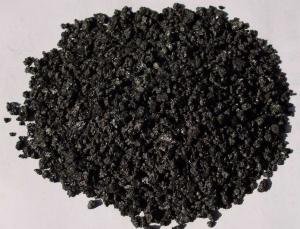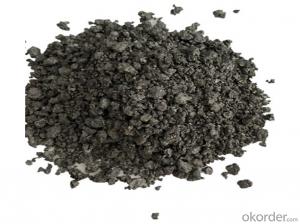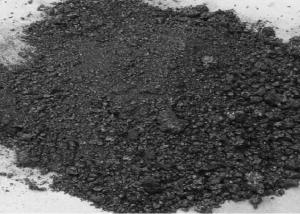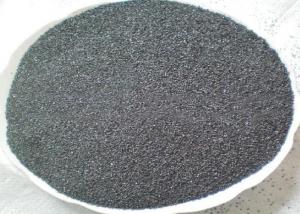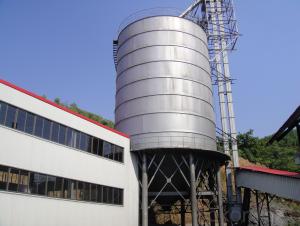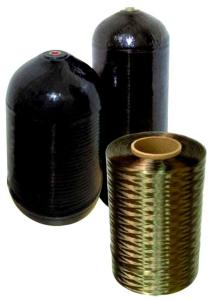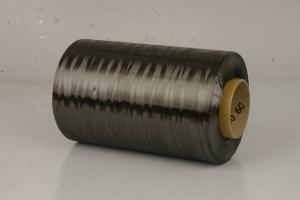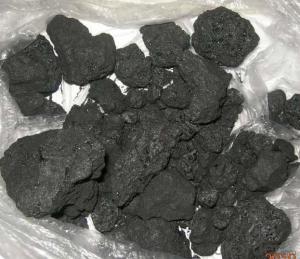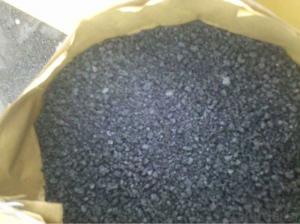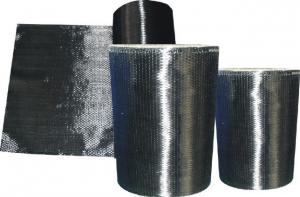CPC/Calcined Petroleum Coke/High Sulfur Graphite
- Loading Port:
- Tianjin
- Payment Terms:
- TT OR LC
- Min Order Qty:
- 1 m.t.
- Supply Capability:
- 10000000 m.t./month
OKorder Service Pledge
OKorder Financial Service
You Might Also Like
1.Structure of Calcined Petroleum Coke Description
Calcined Petroleum Coke is made from raw petroleum coke,which is calcined in furnace at a high temperature(1200-1300℃).CPC/Calcined Petroleum Coke is widely used in steelmaking,castings manufacture and other metallurgical industry as a kind of recarburizer because of its high fixed carbon content,low sulfur content and high absorb rate.Besides,it is also a best kind of raw materials for producing artifical graphite(GPC/Graphitized Petroleum Coke) under the graphitizing temperature(2800℃).
2.Main Features of the Calcined Petroleum Coke
High-purity graphitized petroleum coke is made from high quality petroleum coke under a temperature of 2,500-3,500°C. As a high-purity carbon material, it has characteristics of high fixed carbon content, low sulfur, low ash, low porosity etc.It can be used as carbon raiser (Recarburizer) to produce high quality steel,cast iron and alloy.It can also be used in plastic and rubber as an additive.
3. Calcined Petroleum Coke Images
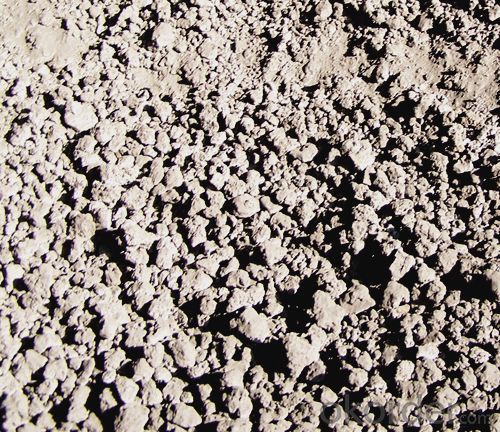
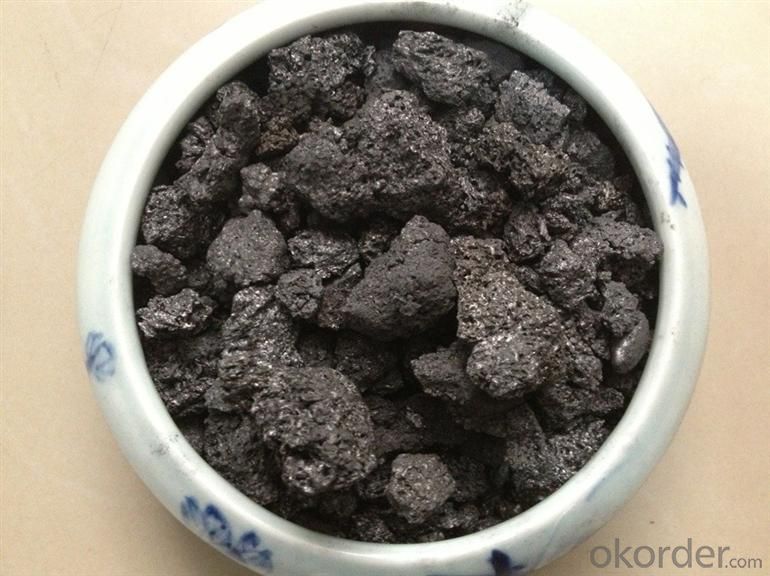
4. Calcined Petroleum Coke Specification
Specifications | TYPEⅠ | TYPEⅡ | TYPEⅢ |
F.C(Min) | 98.5% | 98.5% | 98% |
S(Max) | 0.5% | 0.5% | 0.5% |
ASH(Max) | 0.50%% | 0.80% | 0.80% |
V.M(Max) | 0.50% | 0.70% | 0.70% |
H2O(Max) | 0.5% | 0.5% | 0.5% |
Size: | 0.5-5mm,1-5mm,3-8mm,ect. | ||
5.FAQ of Calcined Petroleum Coke
1). Q: Are you a factory or trading company?
A: We are a factory.
2). Q: Where is your factory located? How can I visit there?
A: Our factory is located in ShanXi, HeNan, China. You are warmly welcomed to visit us!
3). Q: How can I get some samples?
A: Please connect me for samples
4). Q: Can the price be cheaper?
A: Of course, you will be offered a good discount for big amount.
- Q: What are the potential uses of carbon nanomaterials in medicine?
- Carbon nanomaterials have immense potential in medicine due to their unique properties. They can be used for targeted drug delivery, imaging, tissue engineering, and diagnostics. Carbon nanotubes, for example, can transport drugs directly to cancer cells, reducing side effects. Additionally, carbon nanomaterials can provide high-resolution imaging of tissues and organs, aiding in early disease detection. Furthermore, they can be used to create scaffolds for tissue regeneration, promoting the growth of new cells and tissues. Overall, carbon nanomaterials hold great promise for revolutionizing medicine and improving patient outcomes.
- Q: What is carbon black pigment?
- Carbon black pigment, used predominantly as a coloring agent in various applications, is a finely divided form of carbon. It is derived from the incomplete combustion or thermal decomposition of hydrocarbons like coal tar, petroleum, or natural gas, resulting in the formation of extremely small particles with a high surface area. Renowned for its intense black color, high tinting strength, and excellent UV stability, carbon black pigment finds extensive use in the manufacture of inks, paints, coatings, plastics, rubber, and other materials. The particles disperse effectively in these mediums, ensuring a deep and uniform black hue. Apart from its coloring prowess, carbon black pigment boasts several other desirable attributes. It enhances the durability, weather resistance, and electrical conductivity of materials. Additionally, it augments the UV resistance and absorption properties of coatings and plastics, thereby safeguarding against fading and degradation caused by sunlight exposure. Furthermore, carbon black pigment exhibits chemical inertness, rendering it suitable for a wide range of applications without triggering undesirable chemical reactions. It is also non-toxic and has a minimal environmental footprint, making it a preferred choice across multiple industries. In summary, carbon black pigment serves as a versatile and highly utilized additive that imparts deep black coloration, durability, and improved performance to various materials. Its exceptional properties make it an indispensable component in numerous industries, contributing to the production of high-quality products.
- Q: Can carbon be recycled?
- Indeed, carbon has the potential to undergo recycling. Carbon recycling pertains to the process of capturing and reutilizing carbon dioxide (CO2) emissions rather than releasing them into the atmosphere. There exist various approaches to carbon recycling, which include: 1. Carbon capture and storage (CCS): This procedure entails the capture of CO2 emissions from power plants or industrial facilities, followed by their storage underground or in deep ocean formations. CCS aids in preventing the release of CO2 into the atmosphere, thereby reducing its impact on climate change. 2. Carbon capture and utilization (CCU): CCU involves capturing CO2 emissions and transforming them into valuable products. For instance, CO2 can be converted into fuels, chemicals, or construction materials through a range of chemical and biological processes. 3. Enhanced oil recovery (EOR): This technique encompasses the injection of captured CO2 into oil reservoirs to enhance the quantity of recoverable oil. In addition to recycling carbon, it also boosts oil production. 4. Biological carbon sequestration: This method employs plants, trees, and other biological organisms to absorb CO2 from the atmosphere through photosynthesis. By promoting reforestation, afforestation, and sustainable land management practices, we can augment carbon sequestration and offset emissions. While carbon recycling technologies are still under development and refinement, they present promising solutions for mitigating greenhouse gas emissions and addressing climate change. By recycling carbon, we can diminish our dependence on fossil fuels, minimize the release of CO2 into the atmosphere, and strive towards a more sustainable and low-carbon future.
- Q: What are the consequences of increased carbon emissions on human health?
- Increased carbon emissions have numerous consequences on human health. Firstly, carbon emissions contribute to the formation of air pollution, specifically fine particulate matter (PM2.5) and ground-level ozone, which can lead to respiratory issues such as asthma, bronchitis, and other respiratory diseases. Additionally, exposure to air pollution from carbon emissions has been linked to an increased risk of cardiovascular diseases, including heart attacks and strokes. Moreover, carbon emissions contribute to climate change, resulting in more frequent and intense heatwaves, extreme weather events, and the spread of infectious diseases. These phenomena can have direct and indirect impacts on human health, leading to heat-related illnesses, injuries, mental health issues, and the displacement of communities. Overall, the consequences of increased carbon emissions on human health are significant and require urgent action to mitigate their effects.
- Q: What are fossil fuels and how are they formed?
- Fossil fuels are natural resources that are formed from the remains of ancient plants and animals. They are non-renewable sources of energy that have been used by humans for centuries. The three main types of fossil fuels are coal, oil, and natural gas. The formation of fossil fuels begins with the organic matter that comes from plants and animals. Over millions of years, this organic matter becomes buried deep within the Earth's crust. The process of fossilization occurs as layers of sediment build up over time, putting pressure and heat on the organic matter. In the case of coal, the organic matter is mostly plant material that has been compacted and heated over time. As the pressure and temperature increase, the plant material undergoes a chemical transformation, gradually turning into coal. The formation of oil and natural gas is slightly different. It starts with the remains of tiny marine microorganisms, such as plankton, that have settled at the bottom of ancient oceans. Over time, these organic materials become buried under layers of sediment and are subjected to immense heat and pressure. Under these conditions, the organic matter gets transformed into a mixture of hydrocarbons, which is the main component of oil and natural gas. The oil and gas then migrate through porous rocks until they are trapped by impermeable layers, forming oil or gas reservoirs. Overall, the formation of fossil fuels is a slow geological process that takes millions of years. It requires specific conditions of heat, pressure, and burial to convert the organic matter into coal, oil, or natural gas. Due to their limited availability and the environmental impact of their combustion, there is an increasing focus on transitioning to renewable energy sources as a more sustainable alternative.
- Q: How do you use carbon fourteen to measure the age?
- One is obvious a small amount of sample, only 1 ~ 5 mg samples can be, such as a piece of fabric, bone chips, toner trace of ancient ceramics in the surface or pores can be measured; while the conventional carbon - 14 dating rules 1 to 5 grams of samples differ by 3 orders of magnitude. The two is high sensitivity. The sensitivity of 10-15 to 10-16 isotope ratio measurement; while the conventional carbon - 14 dating rules with a difference of 5 to 7 orders of magnitude. Three is a short measurement time, measurement of modern carbon to reach 1% accuracy, only 10 to 20 minutes; while the conventional carbon - 14 dating is 12 ~ 20 hours. It is due to carbon - 14 accelerator mass spectrometry dating method has the advantage, since its inception, has been paid attention to by archaeologists, paleontologists and geologists, and is widely used. It can be said that within 50000 years of cultural relics on the determination of samples, carbon - 14 accelerator mass spectrometry dating method is determined the accuracy of a maximum of 1. carbon. 14 is a radioactive isotope of carbon, was found in 1940. It is produced by cosmic rays collide with a nitrogen atom in the air, which has a half-life of about 5730 years, as the decay of beta decay, 14 atoms into carbon nitrogen atoms.
- Q: How does carbon dioxide affect textile production?
- Carbon dioxide can have various impacts on textile production. Firstly, the production of carbon dioxide during the manufacturing process of textiles contributes to the overall greenhouse gas emissions, which exacerbates climate change. This can lead to long-term consequences such as extreme weather events, rising temperatures, and sea-level rise, all of which can disrupt the supply chain and production of textiles. Moreover, carbon dioxide emissions from textile production contribute to air pollution, which can have adverse effects on human health. The release of this greenhouse gas can lead to respiratory problems and other respiratory diseases in workers exposed to high levels of carbon dioxide. Additionally, carbon dioxide is often used as a part of the dyeing and finishing process in textile production. This can have negative consequences for the environment as well. Carbon dioxide can contribute to water pollution when it is released into water bodies during the dyeing process, leading to the contamination of water sources and harming aquatic life. Furthermore, the excessive use of carbon dioxide in textile production can also have economic implications. As carbon dioxide is a byproduct of burning fossil fuels, its production is inherently linked to the consumption of non-renewable resources. The reliance on fossil fuels can make textile production vulnerable to price fluctuations, as the cost of carbon dioxide emissions and energy production can vary significantly. To mitigate the negative impacts of carbon dioxide on textile production, various measures can be taken. These include adopting cleaner production techniques and technologies that reduce carbon dioxide emissions, such as the use of renewable energy sources or implementing carbon capture and storage systems. Additionally, investing in sustainable and environmentally-friendly materials, such as organic cotton or recycled fibers, can also help reduce the carbon footprint of textile production. Overall, the reduction of carbon dioxide emissions in textile production is crucial for the industry to become more sustainable and mitigate its environmental and health impacts.
- Q: How does carbon impact the formation and intensity of hurricanes?
- Carbon, specifically in the form of carbon dioxide, plays a significant role in impacting the formation and intensity of hurricanes. The increase in carbon emissions due to human activities, such as burning fossil fuels, deforestation, and industrial processes, has led to a rise in atmospheric carbon dioxide levels. This, in turn, contributes to the phenomenon known as global warming. Global warming, caused by the greenhouse effect, leads to an increase in sea surface temperatures. Warmer ocean waters provide the necessary energy and moisture for hurricanes to form and intensify. As the atmosphere warms, it can hold more water vapor, which acts as fuel for hurricanes, increasing their potential for stronger and more intense storms. The warming of the atmosphere also alters the atmospheric conditions that influence hurricane formation. It changes the vertical wind shear, which is the difference in wind speed and direction at different altitudes. Low wind shear is favorable for hurricane development, as it allows the storm to organize and strengthen. However, global warming can disrupt this balance and create unfavorable wind shear patterns, inhibiting hurricane development. Furthermore, the increased carbon dioxide levels in the atmosphere contribute to ocean acidification. As carbon dioxide dissolves in seawater, it forms carbonic acid, which lowers the pH of the ocean. Acidic waters can have detrimental effects on marine life, including coral reefs, which act as natural barriers against storm surges during hurricanes. The degradation of these ecosystems weakens their ability to protect coastal communities from the destructive impacts of hurricanes. In summary, carbon emissions and the subsequent increase in carbon dioxide levels have a profound impact on the formation and intensity of hurricanes. The warming of the atmosphere and ocean, along with changes in wind shear patterns, create conditions that favor the development and intensification of hurricanes. Additionally, ocean acidification resulting from excessive carbon dioxide levels weakens natural defenses against storm surges. It is crucial to address the issue of carbon emissions and reduce our carbon footprint to mitigate the potential consequences of climate change and its impact on hurricanes.
- Q: How does carbon affect the formation of landslides?
- The formation of landslides is not directly influenced by carbon. Instead, natural factors such as heavy rainfall, earthquakes, or volcanic activity, as well as human activities like deforestation or construction, primarily trigger landslides. However, carbon does have an indirect role in landslides through its impact on the environment. The emission of excessive carbon dioxide (CO2) is primarily caused by human activities like burning fossil fuels and deforestation, and this contributes to climate change. As a result of climate change, rainfall events become more frequent and intense, increasing the likelihood of landslides. The increased rainfall saturates the soil, making it heavier and more susceptible to sliding, particularly on steep slopes. Deforestation is another way in which carbon indirectly affects landslides. Trees play a crucial role in stabilizing slopes by anchoring the soil with their root systems. However, when forests are cleared for agriculture, urbanization, or logging, the loss of tree cover weakens the soil's stability and raises the risk of landslides. Furthermore, the absence of vegetation reduces rainfall absorption, leading to increased surface runoff and erosion, further destabilizing slopes and making them more prone to landslides. In conclusion, while carbon itself does not directly cause landslides, its impact on climate change and deforestation can indirectly contribute to the occurrence and severity of landslides. Addressing carbon emissions and promoting sustainable land management practices are essential to mitigate the risk of landslides and preserve the stability of slopes.
- Q: What is the boiling point of carbon?
- The boiling point of carbon is approximately 4,827 degrees Celsius (8,740 degrees Fahrenheit).
Send your message to us
CPC/Calcined Petroleum Coke/High Sulfur Graphite
- Loading Port:
- Tianjin
- Payment Terms:
- TT OR LC
- Min Order Qty:
- 1 m.t.
- Supply Capability:
- 10000000 m.t./month
OKorder Service Pledge
OKorder Financial Service
Similar products
Hot products
Hot Searches
Related keywords


